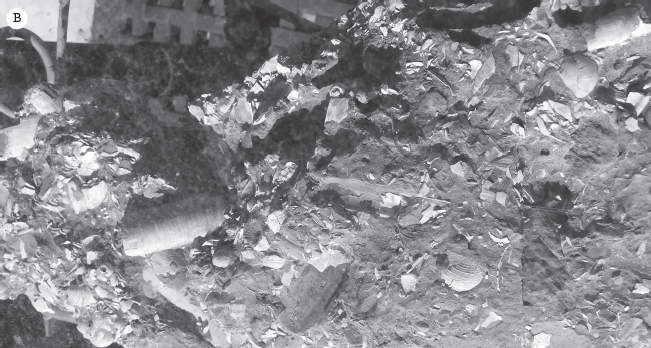Many kids are fascinated with dinosaurs and other prehistoric creatures. Some even dig holes in their backyards or driveways looking for dinosaur bones. Most eventually become discouraged and give up because dinosaur bones are extremely rare, and they are found in only a few places on Earth.
If you wanted to find fossils, where would you look? Why are certain rocks and certain places good for finding fossils, whereas others have none at all?
There are three types of rocks—sedimentary, metamorphic, and igneous rocks—but fossils are primarily found only in sedimentary rocks. These rocks are made from the loose grains of sand, gravel, mud, or other particles that weather out of the hard bedrock and are deposited in rivers, floodplains, or at the bottom of the ocean. When animals and plants die, their hard parts (bones, shells, wood) may be buried. If the conditions are right, these hard parts will be deeply buried and then be covered by loose sediments (fig. 3.1). Over time the sands are cemented together by minerals in the groundwater to become sandstone (fig. 3.2A), or the soft mud grains are squeezed and compressed until they become a hard splintery rock called shale (fig. 3.2B).
Figure 3.1 ▲
How a dinosaur skeleton becomes a fossil. (Illustration by Mary Persis Williams)
Figure 3.2 ▲
(A) Mollusc fossils inside a sandstone. (B) A dense mass of mollusc shells, including razor clams and many other kinds of molluscs, from the middle Miocene Olcese Sand, Bakersfield, California. ([A] Courtesy of Wikimedia Commons; [B] photograph by the author)
These sedimentary rocks might then be deeply buried in the earth’s crust. Millions of years later, these ancient rocks might be uplifted to the surface and crumpled upward by the collision of continents to form a mountain belt. Or they might be tilted on their side, and erosion will expose the ancient sediment. Or they might be brought to the surface by erosion, and rain and frost and wind will break down the fossils as well as the rock surrounding them (fig. 3.3). This has been happening for millions of years, and most of the fossils that were once buried have already been exposed by erosion and were destroyed before humans got around to collecting them. Only in the past 200 years have humans (especially paleontologists) been actively looking for, collecting, and preserving fossils before they are lost forever. Fossil collectors have visited only small parts of the earth more than a few times. Even today, large areas of unexplored land remain in remote regions, and most fossils there will be lost before any human sees them in time to save them.
Figure 3.3 ▲
Rocks are formed by various natural processes. Of the three types of rocks, fossils are generally found only in sedimentary rocks. (Illustration by Mary Persis Williams).
In addition to sands and gravels and muds, another common kind of sedimentary rock is limestone, and it is literally made of fossils—mostly the broken fragments of shells of sea creatures that lived millions of years ago (see fig. 1.2B). If you happen to be collecting in an area where limestones are common in the bedrock, fossils are everywhere. However, most of these fossils may be highly fragmentary and are not worth collecting.
Igneous rocks are formed by the cooling of magma, or molten rock, that comes up from the hot deep interior of the earth (fig. 3.4A). This can happen when a volcano explodes and scatters volcanic ash across the landscape (as happened at Mount St. Helens in Washington in 1980), or when lava flows pour out of an erupting volcano (as happens on Kilauea on the Big Island of Hawaii nearly every year or so). The magma might remain underground without ever erupting from a volcano, but instead cool in a deep magma chamber until it is a hard crystalline rock like granite (fig. 3.4B). Either way, igneous rocks rarely preserve fossils. Hot magma usually incinerates or vaporizes the soft tissues of an animal or plant without leaving a trace. In only a few cases has volcanic ash blown for a long distance and buried a creature, preserving it in some way.
Figure 3.4 ▲
(A) Igneous rocks include lava flows, often with a pattern of polygonal fractures called columnar jointing, which are formed as they cool from a molten state. These lava flows are from the Isle of Staffa in Scotland and have been carved by the waves to create Fingal’s Cave. (B) Magma chambers produce coarse-grained igneous rocks, such as this granitic boulder from the Sierra Nevada Mountains in California. (C) Metamorphic rocks have been under intense pressure and hot temperatures, which results in a layered structure known as foliation. This 1.7 billion-year-old Mendenhall Gneiss from the San Gabriel Mountains is foliated but also has been intensely folded. (Photographs by the author)
The third class of rocks are metamorphic rocks. They are formed when igneous or sedimentary rocks descend deep into the earth’s crust and are put under immense pressures and extremely hot temperatures (fig. 3.4C). These conditions transform the original rock into a new rock with new minerals and a new fabric. Any remains of plants or animals are destroyed in this process, so there are no fossils to be found in metamorphic rocks (unless the rocks are just barely metamorphosed).







